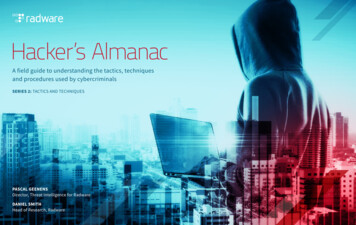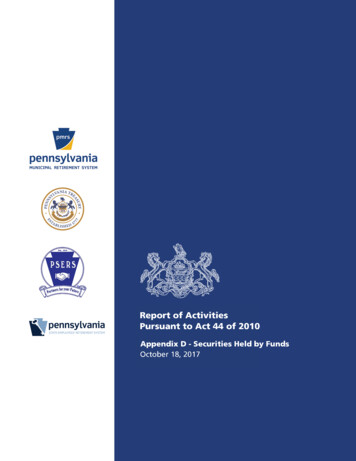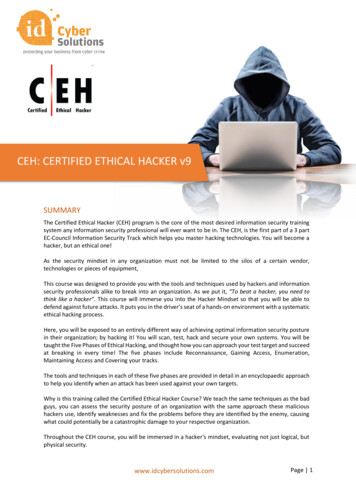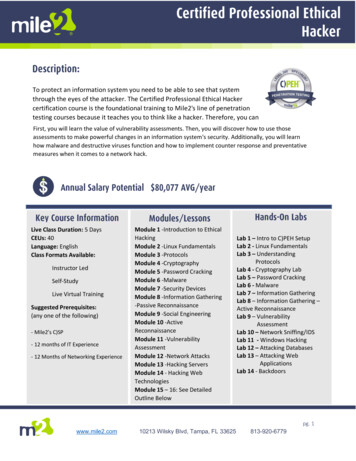
Transcription
Hacker’s AlmanacA field guide to understanding the tactics, techniquesand procedures used by cybercriminalsSERIES 2: TACTICS AND TECHNIQUESPASCAL GEENENSDirector, Threat Intelligence for RadwareDANIEL SMITHHead of Research, Radware
IntroductionTactics, Techniques & ProceduresMITRE ATT&CK Adversary Tactics & TechniquesReferencesTable of FiguresAbout the AuthorsAbout RadwareIntroductionToday’s cybersecurity threats require both full-spectrum solutions and an in-depthknowledge of the threat landscape. One of the best ways to stay abreast of what’shappening in the ever-evolving threat landscape is to study and contribute to thestandardization of threat intelligence. By analyzing and profiling the patterns ofthreat actors and providing that information to the security community, it can betterunderstand criminal behavior and how criminals orchestrate specific attacks. A deeperunderstanding of cybercriminals’ tactics, techniques and procedures (TTPs) will helpthe community and organizations understand how to prepare, respond to and mitigatemost threats. Understanding an adversary’s TTPs allows an organization to map themto its security strategy so it can harden, detect, isolate, deceive and evict threat actorsthat are targeting its environment.PrevNextRadware Hacker’s Almanac 20212
IntroductionIntroductionTactics, MITRE ATT&CK Adversary Tactics & TechniquesReferencesTable of FiguresAbout the AuthorsAbout RadwareTactics, Techniques and ProceduresThe attack landscape continues to grow rapidly, and with that growth comes thechallenge of tracking the TTPs used by different threat actors. The Computer SecurityResource Center of the National Institute of Standards and Technology (NIST) describesTTPs as the behavior of a threat actor. Tracking behavior has become an essentialconcept for cyberthreat intelligence analysts. By profiling and documenting criminalTTPs, defenders can better understand criminal behavior and how they operate andorchestrate their attacks. Leveraging TTPs, defenders can prepare, respond to andmitigate both current and future threats.TACTICS refer to what a threatactor is trying to accomplish.For example, the tactic“Persistence” describes theadversary’s goal: to persistin the target environment.The tactic “Initial Access”describes the threat actor’sgoal: to gain a foothold into anorganization’s network.TECHNIQUES are detaileddescriptions of the behavior oractions performed to achievea specific goal. For example, atechnique to gain initial accessto an organization could includePhishing. A technique to achievepersistence could be creating anaccount or scheduling a task orjob on the system.PROCEDURES provide thetechnical details about howa threat actor performs atechnique to accomplishtheir objective. For example,procedures for creating ascheduled task are the “at”command on Linux and Windowsor the “cron” and “launchd”daemon configuration on Linux.Unfortunately, tracking threat actor behavior is challenging due to a lack of a single standardized framework thatguides researchers and analysts. As mentioned in Series 1 (The Threat Actors), the diversity in naming conventionsused by different organizations has made documenting, reporting and reviewing threat actors extremely difficult.Depending on the organization attributed to a digital attack, the threat group known as APT10 by Mandiant isalso known as menuPass by FireEye, Stone Panda by CrowdStrike or Red Apollo, Cloud Hopper and POTASSIUMby Microsoft. Fortunately, over the last few years, the industry has widely begun to adopt MITRE’s ATT&CK [1]Framework, which aims at a community-driven, common taxonomy and provides, among other things, a catalog ofthreat groups and their known aliases.PrevNextRadware Hacker’s Almanac 20213
IntroductionIntroductionTactics, MITRE ATT&CK ATT&CK Adversary Tactics & TechniquesReferencesTable of FiguresAbout the AuthorsAbout RadwareMITRE ATT&CKThe MITRE ATT&CK framework is an open and universally accessible knowledge base thatcontains adversary tactics and techniques based on real-world observations. ATT&CKstands for Adversarial Tactics, Techniques, and Common Knowledge. The knowledgebase was developed by the MITRE Corporation [2], a not-for-profit organization thatmanages federally funded research and development centers (FFRDCs) supporting theU.S. government. Over the years, MITRE ATT&CK has become a valuable resource fororganizations that wish to better understand the specific threats they may face.The knowledge base is subdivided into several matrices covering enterprise, mobile and industrial control systems [3].The enterprise matrix tracks adversary threats and profiles them in a simple-to-view format that details actionsadversaries may take to compromise your enterprise network. The matrix provides an exhaustive list of known attacktechniques organized into 14 different tactic categories ranging from reconnaissance to impact.Each matrix provides filtered views allowing organizations to focus on specific adversarial tactics and techniques. Theenterprise matrix provides filtered views for Microsoft Windows, macOS, Linux, cloud, network and containers. Themobile matrix provides filters for Android and iOS.This knowledge base is continuously updated and allows organizations to conduct updated audits and improvementsin their defensive policies and detection methods as adversarial tactics and techniques are added. The MITRE ATT&CKframework also provides a common language across industries. Incorporating the structure and naming conventions usedin the MITRE ATT&CK matrix into an organization’s security policy will enable a common language across the organizationand the industry, making it easier to document, report and talk about adversary activities, threats and threat groups.Continued on next pagePrevNextRadware Hacker’s Almanac 20214
IntroductionIntroductionTactics, MITRE ATT&CK ATT&CK Adversary Tactics & TechniquesReferencesTable of FiguresContinued from previous pageaboutReconnaissanceActiveScanningAbout RadwareHost InformationGatherVictim IdentityInformationGatherVictim NetworkInformationGather VictimOrg InformationPhishing forInformationSearch ClosedSourcesSearchOpen TechnicalDatabasesSearch formsLinux, macOS, Windows,Azure AD, Office 365,SaaS, IaaS, Google Workspace,PRE, Network, ContainersEnterpriseATT&CK v9MatrixGather VictimAbout the loitPublic-FacingApplicationExternalRemote hRemovable MediaSupply cutionCommandand DeployContainerExploitation forClient untManipulationBITS JobsBootor Logon AutostartExecutionBoot or LogonInitializationScriptsBrowserExtensionsNative APICompromise oftwareDeployment ToolsSystemServicesUserExecutionWindows ManagementInstrumentationSoftware BinaryCreate or ModifySystem ProcessEvent TriggeredExecutionExternalRemote ServicesHijackExecution FlowImplantInternal ImageModifyAuthenticationProcessOffice ApplicationStartupPre-OS BootScheduledTask/JobServer ilegeEscalationDefenseEvasionAbuse ElevationAbuse ElevationControl MechanismControl MechanismAccess TokenManipulationBootor Logon AutostartExecutionBoot or LogonInitializationScriptsCreate or ModifySystem ProcessDomain PolicyModificationEscapeto HostEvent TriggeredExecutionExploitationfor PrivilegeEscalationHijackExecution Access TokenManipulationCredentialAccessBrute ForceCredentials fromPassword StoresBITS JobsExploitation forBuild Imageon HostForcedAuthenticationDeobfuscate/DecodeFilesor InformationDeployContainerDirectVolume AccessDomain PolicyModificationExecutionGuardrailsExploitation forDefense EvasionFile and kExecution FlowImpairDefensesIndicatorRemoval on HostIndirect ocessModifyCloud ComputeInfrastructureModifyRegistryModifySystem ImageNetwork BoundaryBridgingObfuscated Filesor InformationCredential AccessForge uthenticationProcessNetworkSniffingOS CredentialDumpingSteal ApplicationAccess TokenSteal or ForgeKerberos TicketsSteal WebSession dCredentialsDiscoveryAccountDiscoveryExploitation ofRemote ServicesApplicationWindow DiscoveryBrowser nalSpearphishingLateral ToolTransferRemote ServiceCloud ServiceDashboardCloud ServiceDiscoverySession HijackingRemoteServicesReplicationThroughRemovable MediaSoftwareContainer andResource DiscoveryDomain TrustDiscoveryFile and DirectoryDiscoveryNetwork ServiceScanningNetwork ShareDiscoveryNetworkSniffingPassword PolicyDiscoveryPeripheralDevice DiscoveryPermissionGroups DiscoveryProcessDiscoveryQueryRegistryRemote SystemDiscoveryDeployment ToolsTaint SharedContentUse llected ta from CloudStorage ObjectDatafrom ConfigurationRepositoryDatafrom InformationRepositoriesData fromLocal SystemData from NetworkShared DriveData fromRemovable MediaData StagedEmailCollectionInputCaptureMan inthe ommandand ControlExfiltrationImpactApplicationLayer ProtocolAutomatedExfiltrationAccountAccess nEncryptedChannelFallbackChannelsIngress ToolTransferMulti-StageChannelsExfiltrationOver AlternativeProtocolData Encryptedfor ImpactCommunicationThroughRemovable MediaNon-ApplicationLayer te AccessSoftwareData TransferSize LimitsExfiltrationOver C2 ChannelExfiltrationOver OtherNetwork MediumExfiltration OverPhysical MediumExfiltrationOver Web ServiceScheduledTransferTransfer Datato Cloud sk WipeEndpoint Denialof ServiceFirmwareCorruptionInhibit SystemRecoveryNetwork Denialof ServiceResourceHijackingService StopSystemShutdown/RebootTrafficSignalingWeb ServiceSoftwareDiscoverySystem InformationDiscoverySystem LocationDiscoverySystem NetworkConfigurationDiscoverySystem NetworkConnectionsDiscoveryPre-OS BootSystem Owner/UserProcessInjectionRogue DomainControllerSystem tem TimeDiscoveryVirtualization/SandboxEvasionSigned BinaryProxy ExecutionSigned ScriptProxy ExecutionSubvert ted DeveloperUtilitiesProxy ExecutionUnused/UnsupportedCloud RegionsUse lization/SandboxEvasionFigure 1: MITRE ATT&CK enterprise matrix [4]WeakenEncryptionXSL ScriptProcessingPrevNextRadware Hacker’s Almanac 20215
IntroductionTactics, Techniques & ProceduresMITRE ATT&CK Adversary naissanceReconnaissanceResource DevelopmentAdversary Tactics and Techniques: Reconnaissance (TA0043)Before any operation begins, a threat actor or group must conduct reconnaissance to gather information about theirtarget. This process could include anything from active scanning and gathering information about networks andsystems to researching executives’ and employees’ professional and personal lives.RECONNAISSANCE IN ACTIONInitial AccessMEMCACHED AMPLIFICATION ATTACK [5] [6]ExecutionOBJECTIVE: Create a list of Memcached1 amplification servers forDDoS attacksPersistencePrivilege EscalationDefense EvasionCredential AccessDiscoveryLateral MovementCollectionCommand and ControlExfiltrationImpactReferencesTable of FiguresTARGET: Exposed Memcached serversTECHNIQUE: Active Scanning – Vulnerability Scanning (T1595.002)In February of 2018, several organizations began disclosing large UDPamplified DDoS attacks leveraging exposed Memcached servers. Memcachedis an object caching service designed to be used internally and never intendedto be exposed to the internet. Nonetheless, in February of 2018, hundreds ofthousands of Memcached servers were exposed to the internet. Attackersabused the Memcached service by listening on UDP port 11211 for reflectivevolumetric DDoS attacks with amplification ratios reaching up to 51,000x.The issue was uncovered as GitHub got struck with a then-record-breakingDDoS attack peaking at 1.3Tbps. In the days leading up to the GitHub attack,UDP port 11211 scanning activity was observed, and after the public disclosureof the attack, the number of active scanners quickly escalated. In the daysfollowing the first attack, several large attacks leveraging Memcachedamplification and ranging from 50Gbps to 500Gbps were reported across theFigure 2: Scanning activity targeting UDP port 11211 (source: Radware Deception Network)globe. It wasn’t until most of the 100,000 exposed servers were secured and theMemcached developers released a patch that changed the default behavior ofthe service that the attacks slowed down and the threat was mostly mitigated.Scanning activity for Memcached continues by malicious actors looking for anopportunity and researchers trying to keep the threat under control.1Memcached is a free, open source, high-performance, distributed-memory object caching system, generic in nature, butintended for use in speeding up dynamic web applications by alleviating database load (memcachd.org).Continued on next pageAbout the AuthorsAbout RadwarePrevNextRadware Hacker’s Almanac 20216
IntroductionTactics, Techniques & ProceduresMITRE ATT&CK Adversary Tactics & TechniquesReconnaissanceReconnaissanceResource DevelopmentInitial AccessExecutionPersistencePrivilege EscalationDefense EvasionCredential AccessDiscoveryLateral MovementCollectionCommand and ControlExfiltrationContinued from previous pageATTACKS ON INDUSTRIAL CONTROL SYSTEMS ANDCRITICAL INFRASTRUCTUREOBJECTIVE: Find internet-connected industrial control systems (ICS)and critical infrastructure (CI)TARGET: Exposed ICS controllers and remote desktop hosts foroperational technology (OT)TECHNIQUE: Search Open Technical Databases – Scan Databases(T1596.005)In May 2020, the head of Israel’s National Cyber Directorate confirmed a“synchronized and organized attack” on civilian infrastructure aimed atdisrupting industrial systems that control Israeli water facilities [7]. Damagecould have been done to those systems if Israeli authorities hadn’t stoppedthe attack.Following this incident, the NSA and CISA warned about threat actorsconducting malicious activity against critical infrastructure by exploitinginternet-accessible OT assets [8].Active scanning is effective but “noisy.” There are plenty of honeypotsdeployed across the internet that will detect an increase in scanning activityand give researchers and the community an advance warning about a newforming threat. A less noisy alternative to active scanning is searching forpotential targets in public scan databases, also known as IoT search engines [9],such as Shodan, ZoomEye or Censys.ReferencesLeveraging Shodan to find and access exposed industrial control systems is easyand does not require an account or subscription. A simple search for “Modbus,”for example, returns over 350 systems in the scan database of Shodan.Table of FiguresContinued on next pageImpactFigure 3: Shodan search for “Modbus”About the AuthorsAbout RadwarePrevNextRadware Hacker’s Almanac 20217
IntroductionTactics, Techniques & ProceduresMITRE ATT&CK Adversary Tactics & TechniquesReconnaissanceReconnaissanceContinued from previous pageFollowing one of the exposed HTTP service links on port 8080 providedunauthenticated access to a configuration interface for what seems to be aModbus TCP gateway located in Estonia.Resource DevelopmentInitial AccessExecutionPersistencePrivilege EscalationDefense EvasionCredential AccessFigure 4: User configuration of exposed Modbus gatewayThe default user “web,” which is automatically logged on when accessingthe site, has full permissions to read and alter the configuration of thegateway as well as the values of connected Modbus devices. The gatewaymanufacturer’s website gives a typical use case for this device: an accessprovider to connected energy meters.DiscoveryLateral MovementCollectionCommand and ControlExfiltrationFigure 5: Anybus M-Bus to Modbus TCP gateway application overview(source: www.anybus.com)ImpactIn this particular case, the controlled meters included dozens of water andelectricity meters.ReferencesTable of FiguresContinued on next pageAbout the AuthorsAbout RadwarePrevNextRadware Hacker’s Almanac 20218
IntroductionTactics, Techniques & ProceduresMITRE ATT&CK Continued from previous pageAdversary Tactics & TechniquesReconnaissanceReconnaissanceResource DevelopmentInitial AccessExecutionPersistencePrivilege EscalationDefense EvasionCredential AccessDiscoveryLateral MovementCollectionCommand and ControlExfiltrationImpactFigure 6: Modbus gateway connected metersWithin minutes and with no tools other than a web browser and an anonymizing VPN or TOR browser, anyone can getaccess to carelessly exposed and forgotten OT and ICS systems on the internet.ReferencesTable of FiguresAbout the AuthorsAbout RadwarePrevNextRadware Hacker’s Almanac 20219
IntroductionTactics, Techniques & ProceduresMITRE ATT&CK Adversary Tactics & TechniquesReconnaissanceResource DevelopmentResourceDevelopmentInitial AccessExecutionPersistencePrivilege EscalationDefense EvasionCredential AccessDiscoveryLateral MovementCollectionCommand and ControlExfiltrationImpactAdversary Tactics and Techniques:Resource Development (TA0042)As operations begin, threat actors need to developresources that they will use to conduct their maliciousactivity. Developing resources can include the lawful orunlawful acquisition of network infrastructure, accountsor capabilities such as exploits, tools and services forstaging purposes.RESOURCE DEVELOPMENT IN ACTIONBULLETPROOF HOSTINGOBJECTIVE: Renting that can withstand reports of abuse and where providers are a lot more lenient about whatis hosted on their servers that can be used for malicious activityTARGET: Any malicious activity, including hosting of illegal content, underground forums and criminalmarketplaces, staging servers for attacks and infrastructure for botnetsTECHNIQUE: Acquire Infrastructure – Virtual Private Server (T1583.003)On September 26, 2019, the German police raided and shut down a data center operating from a former NATOmilitary bunker in the town of Traben-Trarbach, Germany [10] [11]. The “Cyberbunker,” run by a man whom authoritiesdescribed as a 59-year-old Dutchman, was offering bulletproof hosting services, promising to keep the hosted servicesand sites operational regardless of legal demands and secure from law enforcement.Located within a former military base, the 5,000-square-meter (54,000-square-foot), five-floor Cold War–era bunker hadbeen converted to house servers, people operating the data center and others who lived and worked there.According to the authorities, the bunker housed the servers for a multitude of darkweb sites selling drugs, hostingchild pornography and conducting other illegal activities. Among the sites hosted was “Wall Street Market,” whichauthorities claim was one of the world’s largest criminal marketplaces known for selling drugs, stolen financial dataand hacking tools until it was taken down in 2019.Daniel Kaye, aka “BestBuy” [12], operated from the Cyberbunker during his attempts to enslave Deutsche Telekomrouters for his Mirai botnet in November 2016. He also used the botnet during his attacks on Lonestar Cell MTN –attacks that would knock the whole country of Liberia off the internet.Continued on next pageReferencesTable of FiguresAbout the AuthorsAbout RadwarePrevNextRadware Hacker’s Almanac 202110
IntroductionTactics, Techniques & ProceduresMITRE ATT&CK Adversary Tactics & TechniquesReconnaissanceContinued from previous pageGROWING A DDoS BOTNETOBJECTIVE: Infect and control new devices to serve as bots, as partof a botnetResource DevelopmentResourceDevelopmentTARGET: Exploitable IoT devicesInitial AccessTECHNIQUE: Compromise Infrastructure – Botnet (T1584.005)ExecutionPersistencePrivilege EscalationDefense EvasionCredential AccessDiscoveryLateral MovementCollectionCommand and ControlExfiltrationImpactThe operators of the Hoaxcalls Botnet [13] [14], also known as the XTC IRCBotnet, had been developing this new IoT botnet since at least August 2019.While the threat actors developed many variants of their bots and leveragednumerous exploits, they have experienced some degree of failure.While most amateur bot herders will stick with the basics of brute forceover Telnet and SSH, others such as Hoaxcalls will branch out and improvetheir botnets by incorporating additional exploits so they can capturemore devices. Bot herders are competing with each other for their shareof vulnerable resources. Those that leverage more recent or undisclosedexploits stand a better chance of infecting more devices than those thatdo not. If there are only a couple of hundred vulnerable devices for a givenexploit, it’s first come, first served.Figure 7: Evolution of vulnerabilities exploited by the Hoaxcalls Botnet (XTC IRC Botnet)In February of 2020, the group behind the Hoaxcalls campaign began toescalate its efforts in an attempt to capture more devices. Their effortsincluded the use of 12 different additional exploits to propagate their botmalware and develop more resources. This process, however, is more trialand error; and while the number seems impressive, not every attempt was asuccessful or fruitful one.ReferencesTable of FiguresAbout the AuthorsAbout RadwarePrevNextRadware Hacker’s Almanac 202111
IntroductionTactics, Techniques & ProceduresMITRE ATT&CK Adversary Tactics & TechniquesReconnaissanceResource DevelopmentInitial AccessInitialAccessExecutionPersistenceAdversary Tactics and Techniques:Initial Access (TA0001)Most operations begin with threat actors or groups tryingto establish an initial foothold in their victims’ network. Togain initial access, a threat actor might attempt severaltechniques that range from simple but effective phishingcampaigns to more sophisticated supply chain attacks orexploitation of remote and public-facing applications usingknown and unknown (zero-day) vulnerabilities.SUPPLY CHAIN ATTACKDefense EvasionOBJECTIVE: Gain a foothold in high-value networks by exploitingtrusted vendor relationshipsDiscoveryLateral MovementCollectionSUNBURST1SolarWinds3SolarWinds OrionUpdate Package2457SolarWinds customers123TARGET: Government departments, private companies4TECHNIQUE: Supply Chain Compromise – Compromise SoftwareSupply Chain (T1195.002)In 2020, FireEye disclosed being the subject of a breach [15]. During itsanalysis, it discovered what turned out to be a global attack campaign: asupply chain attack “trojanizing” SolarWinds Orion software plugin updatesperformed by an advanced and sophisticated threat actor and that distributesa backdoor dubbed SUNBURST. Federal investigators and cybersecurityagents attribute the attacks to part of a Russian espionage operation, mostlikely performed by Russia’s Foreign Intelligence Service [16].POI6Command & ControlInfrastructure6INITIAL ACCESS IN ACTIONPrivilege EscalationCredential AccessSUNSPOT56TeardropRaindropFigure 8: Evolution of vulnerabilities exploited by the Hoaxcalls Botnet (XTC IRC Botnet)ReferencesTable of FiguresContinued on next pageExfiltrationImpactCobaltStrikeThreat actor breaches SolarWindsThreat actor hides backdoor in Orion plugin moduleSolarWinds publishes update package with backdoorSolarWinds customer downloads and installs Orion updateOrion executes and loads backdoored pluginBackdoor initiates contact with C2 and receives commands and exfiltrates dataDuring this attack campaign, a threat actor was able to gain access toSolarWinds development systems and planted malware dubbed SUNSPOT(step 1 in Figure 8). The SUNSPOT malware was particularly insidious in itsoperations and monitored the software build process of the Orion software.When the SUNSPOT malware spotted a running process involved in thecompilation of the software, the malware would replace one of the sourcefiles with a version that contained the SUNBURST backdoor code (step 2).Command and Control8About the AuthorsAbout RadwarePrevNextRadware Hacker’s Almanac 202112
IntroductionTactics, Techniques & ProceduresMITRE ATT&CK Adversary Tactics & TechniquesReconnaissanceResource DevelopmentInitial AccessInitialAccessExecutionPersistencePrivilege EscalationDefense EvasionCredential AccessDiscoveryLateral MovementCollectionCommand and ControlExfiltrationImpactReferencesTable of FiguresContinued from previous pageThe attackers invested a lot of effort to ensure the 3,500 lines of obfuscated code that implemented a backdoor wereproperly inserted and remained undetected to avoid revealing their presence in the build environment.Once the Orion software build was complete, the new code got packaged and signed with an official code-signing certificatefrom SolarWinds (step 3). Then the update was published on the official update servers of SolarWinds and the customersdownloaded the update package (step 4). After verifying the origin of the package through the code-signing certificate,updates were installed, including the backdoored plugin module (step 5). The malware would remain dormant for two weeksafter being deployed and only then would the SUNBURST backdoor call home to the attackers’ command and control (CnC)infrastructure (step 6). The SUNBURST malware was designed to masquerade communications as the Orion ImprovementProgram protocol and stored reconnaissance results within legitimate plugin configuration files to avoid detection.Through the SUNBURST backdoor, the attackers downloaded additional malware into the breached organization(dubbed Teardrop and Raindrop) and subsequently executed a customized Cobalt Strike Beacon2.MIRAI: SIMPLE YET LETHALOBJECTIVE: Gain access to IoT devices such as routers and IP camerasTARGET: IoT devices exposed to the internetTECHNIQUE: Valid Accounts – Default Accounts (T1078.001)The original Mirai botnet didn’t use sophisticated exploits, yet it was able to compromise hundreds of thousandsof devices by running a password-guessing attack on Telnet services using a small dictionary consisting of only 60username and password combinations. It employed a simple, clear-text TCP-based protocol on port 23 for commandand control (CnC) communications. It omitted domains or domain generation algorithms to protect its CnC from beingdiscovered and blacklisted. It had no upgrade features, underscoring that IoT bots don’t require fancy features to dotheir jobs. In fact, IoT botnets such as Mirai can be considered disposable. If an old botnet gets compromised, it can beinstantly tossed out and a new one easily mdreamboxrealtek111111112345123456meinsmtechTable 1: 60 default credentials leveraged by Mirai Telnet exploit module2Cobalt Strike is a paid penetration testing product that allows an attacker to deploy an agent named “Beacon” on the victim machine. Beacon includes a wealth of functionality to the attacker,including but not limited to command execution, key logging, file transfer, SOCKS proxying, privilege escalation, mimikatz, port scanning and lateral movement. Beacon is in-memory and file-less, in that itconsists of stageless or multistage shellcode that was once loaded by exploiting a vulnerability or executing a shellcode loader, and will reflectively load itself into the memory of a process without touching thedisk. It supports C2 and staging over HTTP, HTTPS, DNS and Microsoft’s Server Message Block named pipes as well as forward and reverse TCP. Beacons can be daisy-chained. Cobalt Strike comes with a toolkitfor developing shellcode loaders, called Artifact Kit. [35]About the AuthorsAbout RadwarePrevNextRadware Hacker’s Almanac 202113
IntroductionTactics, Techniques & ProceduresMITRE ATT&CK Adversary Tactics & TechniquesReconnaissanceResource DevelopmentInitial AccessExecutionExecutionPersistencePrivilege EscalationDefense EvasionAdversary Tactics and Techniques:Execution (TA0002)After a threat actor or group has established a foothold,they will proceed to deploy their payload on the targeteddevice or network. Malware can be downloaded andexecuted on a targeted system via a malicious link, a fileexecuted by a user or by executing remote commandsand scripts via command line and script interpreters.EXECUTION IN ACTIONBOTNET DROPPERSOBJECTIVE: Execute malicious code on a compromised deviceTARGET: Internet-exposed IoT devices such as routers, IP cameras, modemsTECHNIQUE: Command and Scripting Interpreter – Unix Shell (T1059.004)The most unsophisticated yet lethal method t
mobile matrix provides filters for Android and iOS. . Hacker’s Almanac 2021 Before any operation begins, a threat actor or group must conduct reconnaissance to gather information about their target. This process could include anything from act










